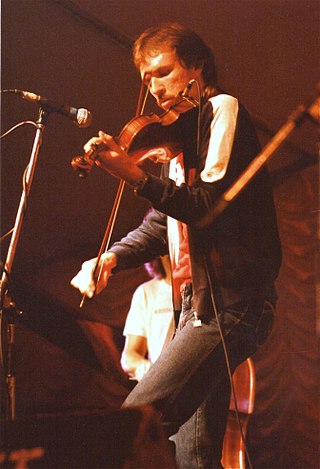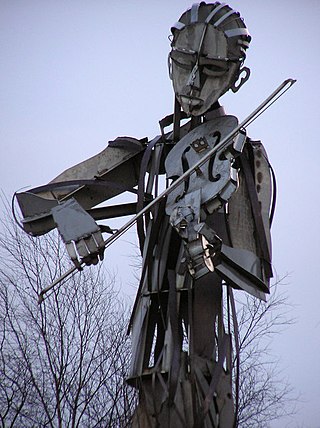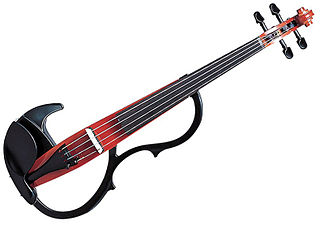
A fiddle is a bowed string musical instrument, most often a violin. It is a colloquial term for the violin, used by players in all genres, including classical music. Although in many cases violins and fiddles are essentially synonymous, the style of the music played may determine specific construction differences between fiddles and classical violins. For example, fiddles may optionally be set up with a bridge with a flatter arch to reduce the range of bow-arm motion needed for techniques such as the double shuffle, a form of bariolage involving rapid alternation between pairs of adjacent strings. To produce a "brighter" tone than the deep tones of gut or synthetic core strings, fiddlers often use steel strings. The fiddle is part of many traditional (folk) styles, which are typically aural traditions—taught "by ear" rather than via written music.

Cajun music, an emblematic music of Louisiana played by the Cajuns, is rooted in the ballads of the French-speaking Acadians of Canada. Although they are two separate genres, Cajun music is often mentioned in tandem with the Creole-based zydeco music. Both are from southwest Louisiana and share French and African origins. These French Louisiana sounds have influenced American popular music for many decades, especially country music, and have influenced pop culture through mass media, such as television commercials.

Old-time music is a genre of North American folk music. It developed along with various North American folk dances, such as square dancing, clogging, and buck dancing. It is played on acoustic instruments, generally centering on a combination of fiddle and plucked string instruments, most often the banjo, guitar, and mandolin. Together, they form an ensemble called the string band, which has historically been the most common configuration to play old-time music. The genre is considered a precursor to modern country music.

Mark O'Connor is an American fiddle player and composer whose music combines bluegrass, country, jazz and classical. A three-time Grammy Award winner, he has won six Country Music Association Musician Of The Year awards and, was a member of three influential musical ensembles; the David Grisman Quintet, The Dregs, and Strength in Numbers.

Cape Breton fiddling is a regional violin style which falls within the Celtic music idiom. Cape Breton Island's fiddle music was brought to North America by Scottish immigrants during the Highland Clearances. These Scottish immigrants were primarily from Gaelic-speaking regions in the Scottish Highlands and the Outer Hebrides. Although fiddling has changed considerably since this time in Scotland, it is widely held that the tradition of Scottish fiddle music has been better preserved in Cape Breton.

Celtic music is primarily associated with the folk traditions of Ireland, Scotland, Brittany and Wales, as well as the popular styles derived from folk culture. In addition, a number of other areas of the world are known for the use of Celtic musical styles and techniques, including Newfoundland, and much of the folk music of Canada's Maritimes, especially on Cape Breton Island and Prince Edward Island.

The fiddle is one of the most important instruments in the traditional repertoire of Irish traditional music. The fiddle itself is identical to the violin, however it is played differently in widely varying regional styles. In the era of sound recording some regional styles have been transmitted more widely while others have become more uncommon.

A five-string violin is a variant of violin with an extra string tuned below the violin's usual range. In addition to the G, D, A, and E strings of a standard violin, a five-string violin typically includes a lower C string. Violins with 6 or more strings may add a low F, low B♭, low E♭, or a soprano violin high A.

Rock violin is rock music that includes violin in its instrumental lineup. This includes rock music only and does not include classical style music using melodic motifs from rock.

Old timefiddle is the style of American fiddling found in old-time music. Old time fiddle tunes are derived from European folk dance forms such as the jig, reel, breakdown, schottische, waltz, two-step, and polka. When the fiddle is accompanied by banjo, guitar, mandolin, or other string instruments, the configuration is called a string band. The types of tunes found in old-time fiddling are called "fiddle tunes", even when played by instruments other than a fiddle.
"Blues fiddle" is a generic term for bowed, stringed instruments played on the arm or shoulder that are used to play blues music. Since no blues artists played violas, the term is synonymous with violin, and blues players referred to their instruments as "fiddle" and "violin".

Canadian fiddle is the aggregate body of tunes, styles and musicians engaging the traditional folk music of Canada on the fiddle. It is an integral extension of the Anglo-Celtic and Québécois French folk music tradition but has distinct features found only in the Western hemisphere.

Cajun fiddle music is a part of the American fiddle music canon. It is derived from the music of southwest Louisiana and southeast Texas, as well as sharing repertoire from the Quebec and Cape Breton Island traditions. It is one of the few extant North American folk music traditions rooted in French chanson. According to Ron Yule, "Louisiana fiddling had its birth roots in Europe, with fiddling being noted as early as the 1400s in Scotland". Zydeco music is a geographically, culturally, and musically related style.
Westerns swing originated in the 1920s and 1930s; small towns in the US Southwest. Although sometimes subject to the term "Texas swing" it is widely associated with Tulsa, others contend that "Western Swing music finds deep roots in the dust bowl of Oklahoma", and its influences include jazz from the major urban centers of the United States. Its stylistic origins lie in Old Time, Western, blues, folk, swing, Dixieland and jazz. Writing in Rolling Stone, Dan Hicks described it as Texas-bred music grafted to jazz, or as "white country blues with a syncopated beat.".
Bluegrass fiddling is a distinctive style of American fiddle playing which is characterized by bold, bluesy improvisation, off-beat "chopping", and sophisticated use of both double-stops and old-time bowing patterns.
Billy Contreras is an American jazz violinist and bluegrass fiddler, multi-instrumentalist, session player and educator.
Vivian Tomlinson Williams was an American fiddler, composer, recording artist, and writer. She won national fiddling titles, including the National Oldtime Fiddlers Contest, and in 2013 she was inducted into the North American Old Time Fiddlers Hall of Fame.

Howard Wight Marshall is an American academic, author, folklorist, historian, and fiddler. He is a professor emeritus and former chair of the Department of Art History and Archeology at the University of Missouri in Columbia, Missouri. In addition to his work on regional folk architecture he researches fiddling traditions in Missouri and the Ozarks, especially the style known as Missouri fiddling. Marshall is the founding director of the Missouri Cultural Heritage Center. In 2018 he received the Missouri Humanities Council Distinguished Literary Award.














